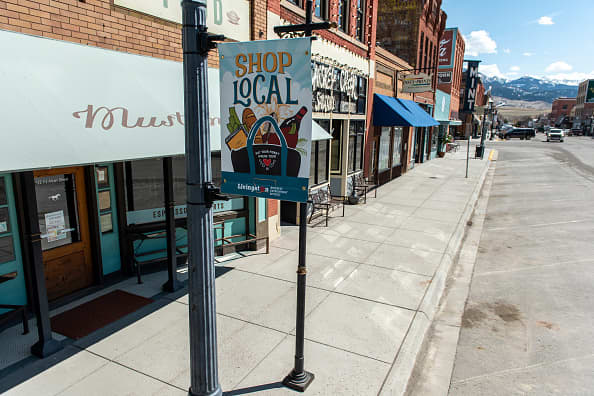A sign reading "Buy Local" with closed restaurants and shops on Main Street on April 10, 2020 in Livingston, Montana.
William Campbell | Corbis via Getty Images
The economic reports showed the double whammy of state shutdowns in mid-March on two pillars of the economy — the consumer and business. The reports were even more dire than expected, and foreshadow even worse declines in April's activity, with state shutdowns affecting areas responsible for more than 90% of the economy.
Homebuilder sentiment also took a big hit during early April, falling the most ever in a one-month period since its inception 35 years ago. Builder confidence for single-family homes plunged 42 points to 30, the lowest level since June 2012, according to the latest National Association of Home Builders/Wells Fargo Housing Market Index.
March retail sales fell 8.7%, a record drop, with the only sign of activity at grocery and beverage stores, which saw sales grow by 25.6%. Economists expected an 8% decline in monthly sales. The consumer accounts for 70% of the economy.
"The economy is clearly in ruins here," said Chris Rupkey, chief financial economist at MUFG Union Bank. "Nobody is buying cars, down 25.6%, nobody is buying furniture, down 26.8%, and eating and drinking places were down 26.5%."
The economic decline, which started in the first quarter is expected to reach its trough in the second quarter. Economists anticipate an unprecedented drop of more than 30% in GDP for the second quarter. JPMorgan economists expect a 40% decline in the second quarter, on top of a 10% drop in the first quarter.
Already negative first-quarter GDP forecasts may also worsen, showing the economy began contracting at a rapid pace when businesses closed down, states ordered residents to stay home, and President Donald Trump told Americans to stay out of restaurants and practice safe distancing.
But Ward McCarthy, chief financial economist at Jefferies, said the retail sales data muddies the outlook for first-quarter GDP, since some sales categories in the data used to calculate it actually improved. They include building materials, up 1.3%, and health and personal care, which climbed 4.3%.
"The bottom line is that consumer spending has fallen off a cliff after being relatively solid for a prolonged period of time," according to McCarthy. "There has been significant substitutions in spending habits as consumers have tried to cope with social distancing. The consumer sector will provide a drag on Q1 and Q2, but it's going to be difficult to estimate the size of the drag."
March retail sales also showed barely a blip in online purchases, only up 3.1%, though consumers are shopping from home. The Commerce Department acknowledged it had difficulty collecting data as many businesses have shut down.
"Retail sales in the fourth quarter of 2008 fell over 8%, but that was over three months," Rupkey said. "This was just one month. ... Consumers are hunkering down at home, only venturing out to go to the grocery store. It's lights out today, and as far as we can tell, it's going to be worse next month."
The Empire State manufacturing survey fell by its biggest margin ever to a historic low, much steeper than any number in the financial crisis and more than double the expected decline in activity in the New York region, hardest hit by the virus.
"Overall, today's manufacturing numbers indicate an expected slowing in activity, but slightly earlier and more widespread than previously thought," noted Citigroup economists. They said the depth of the decline in apparel manufacturing of 16.5% and furniture, down 10%, were surprising.
Jon Hill, senior Treasury strategist at BMO, said the deeper decline in data raises concerns that the sharp recession will morph into a depression, though the $2.2 trillion in fiscal spending and Fed monetary actions could head that off and help drive a rebound that many economists expect to start in the third quarter.
"It's really going to be not only a function of infections declining and whether there's a vaccine, but how will the economy be able to reopen and how quickly, given the depth of the hit to the labor market," Hill said. So far, in just three weeks ended April 4, more than 17 million workers filed claims for unemployment benefits, more than the Great Recession.
"These are very different types of recessions. One is broader economic impact. This is a sudden stop. it's not surprising that things are economically skewed, but we're not playing by typical economic rules," Hill said. "We're playing by health policy rules. It's going to be hard for [Treasury] rates to sell off in any meaningful fashion."
The Commerce Department began tracking retail sales data in the early 1990s, but Grant Thornton chief economist Diane Swonk said the decline was even worse than a more than 7% drop in January 1987. In that month, consumers stopped spending in response to a tax law change that no longer allowed the deduction of interest on credit card debt or car loans.
Investors responded to the March economic reports by dumping stocks and rushing to the safety of Treasury bonds.
The Dow was down more than 2.5% in midday trading, and the retail sector was one of the hardest hit. The XRT, SPDR S&P Retail ETF fell more than 4.5%.
In the Treasury market, investors bid up longer-duration bonds, like the 10-year, more than the shorter, 2-year duration notes. That is creating a so-called flattening trade, meaning the two spreads are moving closer together, a sign of economic duress. The 10-year was at 0.66%, while the 2-year yield was 0.20%.
The bad data also weighed on inflation expectations, pushing market inflation compensation even lower. Traders look at the spread between benchmark and inflation-adjusted Treasurys to get a measure of inflation expectations. Currently, the market shows expectations of inflation at 0.87% on average over the next five years well below the Fed's 2% inflation target.


